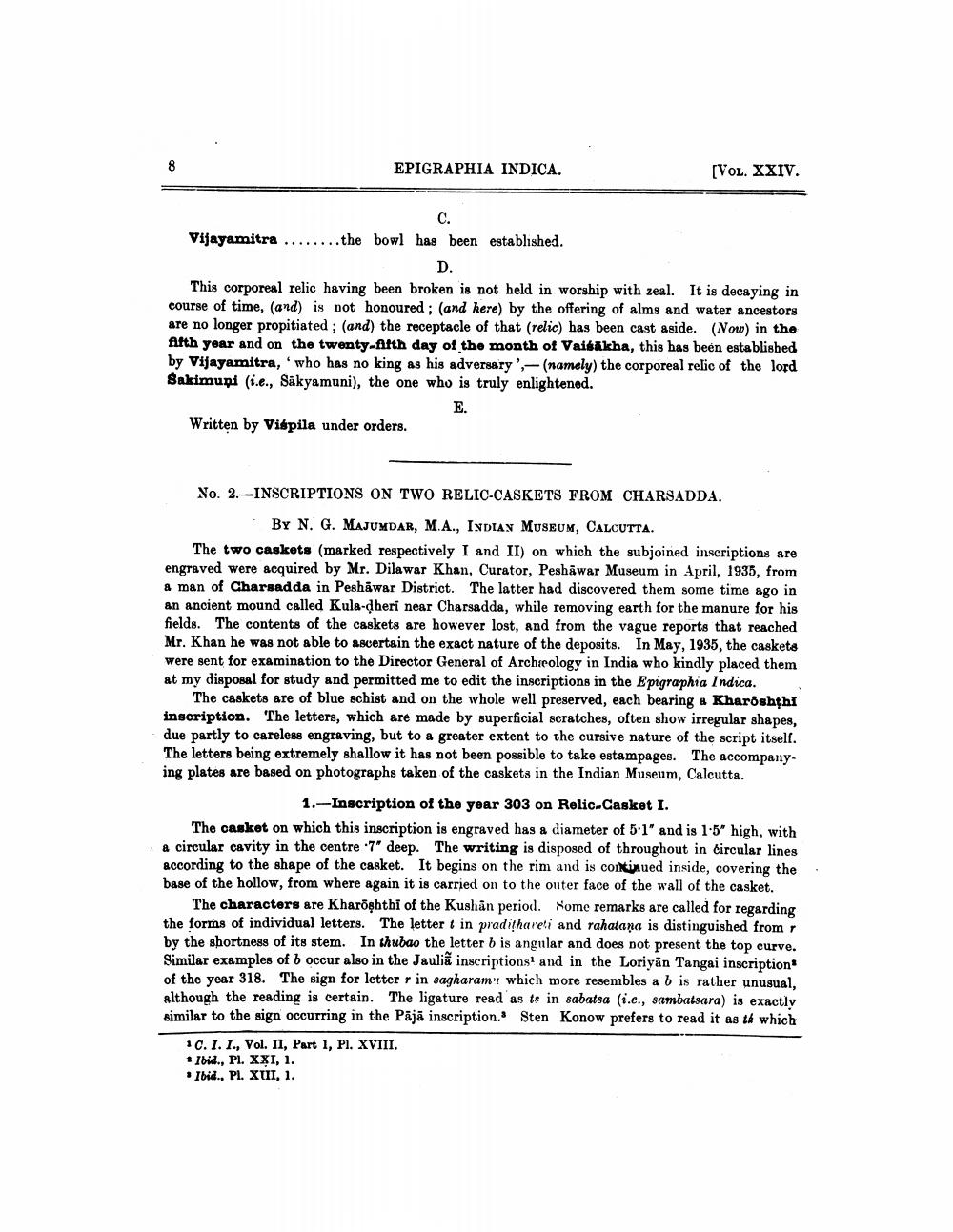________________
8
EPIGRAPHIA INDICA.
C.
Vijayamitra........the bowl has been established.
[VOL. XXIV.
D.
This corporeal relic having been broken is not held in worship with zeal. It is decaying in course of time, (and) is not honoured; (and here) by the offering of alms and water ancestors are no longer propitiated; (and) the receptacle of that (relic) has been cast aside. (Now) in the fifth year and on the twenty-fifth day of the month of Vaisakha, this has been established by Vijayamitra, who has no king as his adversary',- (namely) the corporeal relic of the lord Sakimuņi (i.e., Sakyamuni), the one who is truly enlightened.
6
E.
Written by Vispila under orders.
No. 2.-INSCRIPTIONS ON TWO RELIC-CASKETS FROM CHARSADDA.
BY N. G. MAJUMDAR, M.A., INDIAN MUSEUM, CALCUTTA.
The two caskets (marked respectively I and II) on which the subjoined inscriptions are engraved were acquired by Mr. Dilawar Khan, Curator, Peshawar Museum in April, 1935, from man of Charsadda in Peshawar District. The latter had discovered them some time ago in an ancient mound called Kula-dheri near Charsadda, while removing earth for the manure for his fields. The contents of the caskets are however lost, and from the vague reports that reached Mr. Khan he was not able to ascertain the exact nature of the deposits. In May, 1935, the caskets were sent for examination to the Director General of Archaeology in India who kindly placed them at my disposal for study and permitted me to edit the inscriptions in the Epigraphia Indica.
The caskets are of blue schist and on the whole well preserved, each bearing a Kharoshthi inscription. The letters, which are made by superficial scratches, often show irregular shapes, due partly to careless engraving, but to a greater extent to the cursive nature of the script itself. The letters being extremely shallow it has not been possible to take estampages. The accompanying plates are based on photographs taken of the caskets in the Indian Museum, Calcutta.
1.-Inscription of the year 303 on Relic-Casket I.
The casket on which this inscription is engraved has a diameter of 5.1" and is 1-5" high, with a circular cavity in the centre 7" deep. The writing is disposed of throughout in circular lines according to the shape of the casket. It begins on the rim and is continued inside, covering the base of the hollow, from where again it is carried on to the outer face of the wall of the casket.
The characters are Kharōghthi of the Kushan period. Some remarks are called for regarding the forms of individual letters. The letter t in pradithareti and rahatana is distinguished from r by the shortness of its stem. In thubao the letter b is angular and does not present the top curve. Similar examples of b occur also in the Jaulia inscriptions1 and in the Loriyan Tangai inscription" of the year 318. The sign for letter r in sagharam" which more resembles a b is rather unusual, although the reading is certain. The ligature read as ts in sabatsa (i.e., sambatsara) is exactly similar to the sign occurring in the Päjä inscription. Sten Konow prefers to read it as t which
1 C. I. I., Vol. II, Part 1, Pl. XVIII.
Ibid., Pl. XXI, 1.
Ibid., Pl. XIII, 1.




